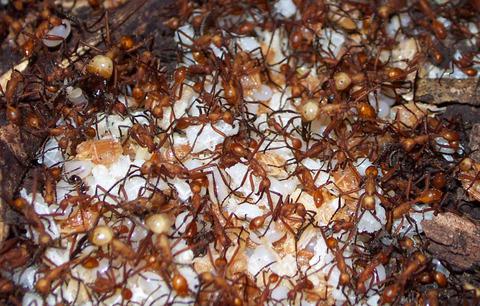当前位置:
X-MOL 学术
›
J. Anim. Ecol.
›
论文详情
Our official English website, www.x-mol.net, welcomes your
feedback! (Note: you will need to create a separate account there.)
Detection of prey odors underpins dietary specialization in a Neotropical top-predator: How army ants find their ant prey
Journal of Animal Ecology ( IF 3.5 ) Pub Date : 2020-03-16 , DOI: 10.1111/1365-2656.13188 John Aidan Manubay 1 , Scott Powell 1
Journal of Animal Ecology ( IF 3.5 ) Pub Date : 2020-03-16 , DOI: 10.1111/1365-2656.13188 John Aidan Manubay 1 , Scott Powell 1
Affiliation

|
Deciphering the mechanisms that underpin dietary specialization and niche partitioning is crucial to understanding the maintenance of biodiversity. New world army ants live in species-rich assemblages throughout the Neotropics and are voracious predators of other arthropods. They are therefore an important and potentially informative group for addressing how diverse predator assemblages partition available prey resources. New World army ants are largely specialist predators of other ants, with each species specializing on different ant genera. However, the mechanisms of prey choice are unknown. In this study, we addressed whether the army ant Eciton hamatum: 1) can detect potential prey odors, 2) can distinguish between odors of prey and non-prey, and 3) can differentiate between different types of odors associated with its prey. Using field experiments, we tested the response of army ants to the following four odor treatments: alarm odors, dead ants, live ants, and nest material. Each treatment had a unique combination of odor sources and included some movement in two of the treatments (alarm and live ants). Odor treatments were tested for both prey and non-prey ants. These data were used to determine the degree to which E. hamatum are using specific prey stimuli to detect potential prey and direct their foraging. Army ants responded strongly to odors derived from prey ants, which triggered both increased localized recruitment and slowed advancement of the raid as they targeted the odor source. Odors from non-prey ants were largely ignored. Additionally, the army ants had the strongest response to the nest material of their preferred prey, with progressively weaker responses across the live ant, dead ant, and alarm odors treatments, respectively. This study reveals that the detection of prey odors, and especially the most persistent odors related to the prey's nest, provides a mechanism for dietary specialization in army ants. If ubiquitous across the Neotropical army ants, then this olfaction-based ecological specialization may facilitate patterns of resource partitioning and coexistence in these diverse predator communities.
中文翻译:

猎物气味检测支持新热带顶级捕食者的饮食专业化:军蚁如何找到它们的猎物
破译支持饮食专业化和生态位划分的机制对于理解生物多样性的维护至关重要。新世界军蚁生活在整个新热带地区物种丰富的群体中,是其他节肢动物的贪婪捕食者。因此,它们是解决不同捕食者组合如何划分可用猎物资源的重要且潜在的信息组。新世界军蚁主要是其他蚂蚁的专业捕食者,每个物种专门捕食不同的蚂蚁属。然而,猎物选择的机制尚不清楚。在这项研究中,我们讨论了军蚁 Eciton hamatum 是否:1) 可以检测潜在的猎物气味,2) 可以区分猎物和非猎物的气味,以及 3) 可以区分与其猎物相关的不同类型的气味。通过田间实验,我们测试了军蚁对以下四种气味处理的反应:警报气味、死蚂蚁、活蚂蚁和巢材料。每种处理都有独特的气味来源组合,并且在其中两种处理(警报和活蚂蚁)中包括一些运动。对猎物和非猎物蚂蚁都进行了气味处理。这些数据用于确定 E. hamatum 使用特定猎物刺激来检测潜在猎物并指导其觅食的程度。军蚁对来自猎物蚂蚁的气味反应强烈,这既引发了局部招募的增加,又在瞄准气味源时减缓了突袭的进程。来自非猎物蚂蚁的气味在很大程度上被忽略了。此外,军蚁对它们喜欢的猎物的巢穴材料有最强烈的反应,分别对活蚂蚁、死蚂蚁和警报气味处理的反应逐渐减弱。这项研究表明,对猎物气味的检测,尤其是与猎物巢穴相关的最持久的气味,为军蚁的饮食特化提供了一种机制。如果在新热带军蚁中无处不在,那么这种基于嗅觉的生态专业化可能会促进这些不同捕食者群落中的资源分配和共存模式。
更新日期:2020-03-16
中文翻译:

猎物气味检测支持新热带顶级捕食者的饮食专业化:军蚁如何找到它们的猎物
破译支持饮食专业化和生态位划分的机制对于理解生物多样性的维护至关重要。新世界军蚁生活在整个新热带地区物种丰富的群体中,是其他节肢动物的贪婪捕食者。因此,它们是解决不同捕食者组合如何划分可用猎物资源的重要且潜在的信息组。新世界军蚁主要是其他蚂蚁的专业捕食者,每个物种专门捕食不同的蚂蚁属。然而,猎物选择的机制尚不清楚。在这项研究中,我们讨论了军蚁 Eciton hamatum 是否:1) 可以检测潜在的猎物气味,2) 可以区分猎物和非猎物的气味,以及 3) 可以区分与其猎物相关的不同类型的气味。通过田间实验,我们测试了军蚁对以下四种气味处理的反应:警报气味、死蚂蚁、活蚂蚁和巢材料。每种处理都有独特的气味来源组合,并且在其中两种处理(警报和活蚂蚁)中包括一些运动。对猎物和非猎物蚂蚁都进行了气味处理。这些数据用于确定 E. hamatum 使用特定猎物刺激来检测潜在猎物并指导其觅食的程度。军蚁对来自猎物蚂蚁的气味反应强烈,这既引发了局部招募的增加,又在瞄准气味源时减缓了突袭的进程。来自非猎物蚂蚁的气味在很大程度上被忽略了。此外,军蚁对它们喜欢的猎物的巢穴材料有最强烈的反应,分别对活蚂蚁、死蚂蚁和警报气味处理的反应逐渐减弱。这项研究表明,对猎物气味的检测,尤其是与猎物巢穴相关的最持久的气味,为军蚁的饮食特化提供了一种机制。如果在新热带军蚁中无处不在,那么这种基于嗅觉的生态专业化可能会促进这些不同捕食者群落中的资源分配和共存模式。










































 京公网安备 11010802027423号
京公网安备 11010802027423号